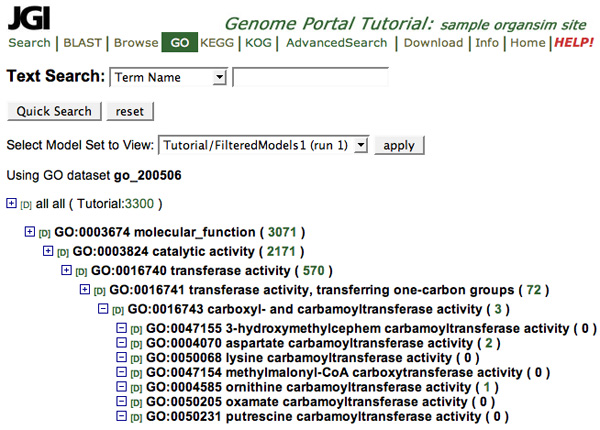
Getting Started - Tools Overview - KEGG - GO - KOG - Track Editor - Browser - BLAST - Protein Page - Annotation Page
The GO Browser
The Genome Portal includes a tool for browsing through the Gene Ontology (GO) and finding genes related to GO terms. GO arranges biological terms under three organizing principles, or ontologies. Each of these is the top level of a deep hierarchical structure of terms. The structures are technically not true hierarchies (they are directed acyclic graphs) in that they allow a child to have more than one parent. Specific gene products are assigned to the terms at various levels in the ontologies.
| Aspect | Definition | Examples |
|---|---|---|
Molecular Function |
the tasks performed by individual gene products |
carbohydrate binding, ATPase activity |
Biological Process |
broad biological goals that are accomplished by ordered assemblies of molecular functions |
Mitosis, purine metabolism |
Cellular Component |
subcellular structures, locations, and macromolecular complexes |
nucleus, telomere, origin recognition complex |
Using the GO browser, you can
Browse through Terms and Gene Products
The GO browser shows all the ancestors and siblings of a term in an indented outline form, a "tree view". When you browse to a term with more than one parent term, you will see the ancestors on all the branches that contain that term.
Navigation
Each term is preceded by a plus + or minus - symbol. The plus + symbol indicates that a term has children that are not currently shown. The minus - symbol indicates that a term has no children or that its children are shown.
- To see a term's children, click the + symbol.
- To hide a term's children, click the - symbol.
As you browse around, your tree view is tracked in your browser's URL string.
- To save a particular tree view and return later, bookmark the URL.
Term Data
For each term, a P or I follows the + or -.
- The P indicates that the term has a "part of" relationship to the parent term.
- The I indicates that the term has an "is a" relationship to the parent term.
Each term also has a [D] after the + or - symbol. This is a link to a definition for the term, if one is available. Listed beneath the definition are functional groupings from other protein databases that would be assigned to that GO term.
The term includes a GO ID number and name.
The line for each term ends with a number in parentheses. This is the number of predicted genes in the genome that are assigned to that term. The number is a link to the Gene Products page for that term.
- To view gene products assigned to a term, click the number in parentheses after the term.
Search for Terms
To do a normal search,
- Select Term Name or Term Accession (GO ID) from the pull-down menu.
- Type a query (e.g.,
carboxyl-for a term name or16743for a term accession number) in the text box. - Click Quick Search.
The search results show: |
|
Accession |
The GO ID. |
Name |
The name of the GO term. |
Type |
The GO ontology in which the term was found. |
Assembly version (e.g., Tutorial) |
The number of gene products found in the assembly being searched. |
- To see the tree view for a result, click the GO ID in the "Accession" column.
- To see the Gene Products page for a result, click the number in the assembly version column.
View Gene Products
You can see a list of the predicted gene products in the JGI genome that are assigned to a particular GO term and its children. You can also view the Protein pages for the gene products and download the sequences.
- To see gene products, click the number in parentheses at the end of the line in the tree view.
The Gene Products page includes the following:
A Text Search
The Term's Lineage
A tree showing the term and its parent relationships but no children.
Gene Products
These are grouped by the GO terms to which they are assigned.
They include: |
|
Gene symbol (e.g., C_1090047) |
JGI's name for the gene product. |
Links |
Links to the gene's Protein page (P) and the annotation area for the gene (A) |
JGI DB |
The name of the assembly version in which the gene product is predicted. |
Quality |
The abbreviated evidence type used to associate the gene product with the term. |
All Xref |
A list of external references for the association of the gene product with the term. |
- To see the Protein page for a gene product, click the letter P in the "Links" column.
- To see the annotation area for a gene product (if it is active), click the letter A in the "Links" column.
- To see a Gene Products page for a child term under which gene products are listed, click the term's GO ID number.
Download options: |
|
Proteins |
Download protein sequences for all the checked gene products. |
Transcripts |
Download nucleotide sequences for all the checked gene products. |
Check All |
Select all gene products currently shown. |
Uncheck All |
Deselect all gene products currently shown. |
